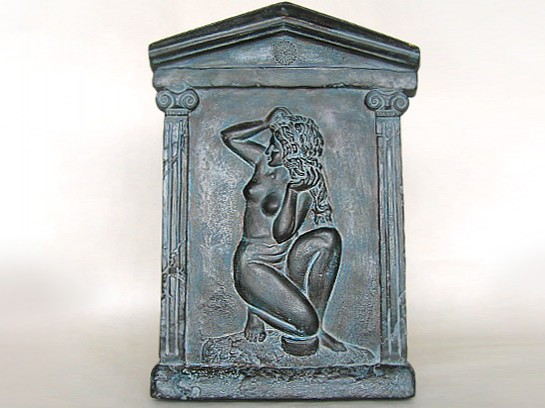Aphrodite is the classical Greek goddess of love, lust, and beauty. Her Roman equivalent is the goddess Venus. Myrtle, dove, sparrow, and swan are sacred to her.
The Greek Goddess Aphrodite has numerous equivalents Inanna (Sumerian counterpart), Ishtar (Babylon), Astarte (Syro-Palestinian), Turan (Etruscan) and Venus (Roman). She has parallels to Indo-European dawn goddesses such as Ushas or Aurora.
The name Αφροδίτη was connected by popular etymology with Άφρός (Aphros) "foam", interpreting it as "risen from the foam" and embodying it in an etiological myth that was already known to Hesiod. It has reflexes in Messapic and Etruscan (whence April), which were probably loaned from Greek. Though Herodotus was aware of the Phoenician origins of Aphrodite, linguistic attempts to derive the name Aphrodite from Semitic Aštoret, via undocumented Hittite transmission, remain inconclusive. A suggestion by Hammarström, rejected by Hjalmar Frisk, connects the name with πρύτανις, a loan into Greek from a cognate of Etruscan (e)pruni, "lord" or similar.
"Foam-arisen" Aphrodite was born of the sea foam near Paphos, Cyprus after Cronus cut off Uranus' testicles and threw them behind him into the sea. Hesiod's Theogony described that the genitals "were carried over the sea a long time, and white foam arose from the immortal flesh with it a girl grew" to become Aphrodite. This fully grown up myth of Venus (the Roman name for Aphrodite), Venus Anadyomene("Venus Rising From the Sea") was one of the iconic representations of Aphrodite, made famous in a much-admired painting by Apelles, now lost, but described in Pliny the Elder Natural History.
Thus Aphrodite is of an older generation than Zeus. Iliad (Book V) expresses another version of her origin, by which she was considered a daughter of Dione, who was the original oracular goddess ("Dione" being simply "the goddess, the feminine form of Δíος, "Dios", the genitive of Zeus) at Dodona. In Homer, Aphrodite, venturing into battle to protect her son, Aeneas, is wounded by Diomedes and returns to her mother, to sink down at her knee and be comforted.
"Dione" seems to be an equivalent of Rhea, the Earth Mother, whom Homer has relocated to Olympus, and refers back to a hypothesized original Proto-Indo-European pantheon, with the chief male god (Di-) represented by the sky and thunder, and the chief female god (feminine form of Di-) represented as the earth or fertile soil. Aphrodite herself was sometimes referred to as "Dione". Once the worship of Zeus had usurped the oak-grove oracle at Dodona, some poets made him out to be the father of Aphrodite.
Aphrodite's chief center of worship remained at Paphos, on the south-western coast of Cyprus, where the goddess of desire had long been worshipped as Ishtar and Ashtaroth. It is said that she first tentatively came ashore at Cytherea, a stopping place for trade and culture between Crete and the Peloponesus. Thus perhaps we have hints of the track of Aphrodite's original cult from the Levant to mainland Greece. Alternatively, Aphrodite was a daughter of Thalassa (for she was born of the Sea) and Zeus.
Product Details
Code: 01523
Dimensions: 34x23cm
Colors: White, Black, Brown
